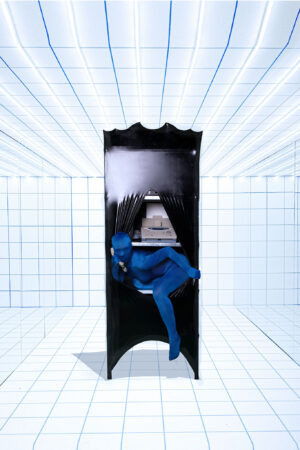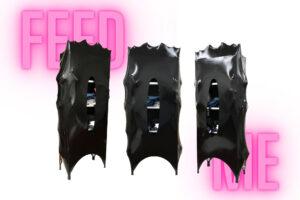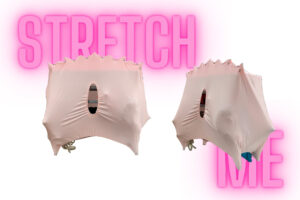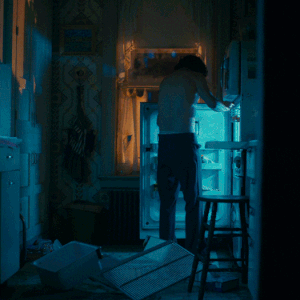
Wie kann aus einem Regal ein Schrank werden?. Mit dem Anspruch nur Textilien oder Textil ähnliches Material zu verwenden.
Ein Regal wird zu einem Schrank, wenn es mit Türen ausgestattet wird, um die Aufbewahrung von Gegenständen zu verbergen, damit Privatsphäre und eine ruhigere Umgebung / Atmosphäre geschafft wird. Dies bewirkt dass, ein Raum ordentlicher und aufgeräumter aussehen zu lassen und verhindert, dass Staub- und Schmutzpartikel auf die Gegenstände fallen. Um meinem Schrank Entwurf Charakter zu geben, lag mein Fokus dabei einen typischen Barock Schrank zu modernisieren, dabei gehe ich auf die Form, die Materialität und die Ornamentik ein.
Während traditionelle Barockschränke oft sperrig sind, kann eine moderne Version eine schlanke und minimalistische Silhouette haben. Außerdem werden Schränke aus der Epoche des Barocks oft aus luxuriösen Holz wie Mahagoni, Kirsche oder Walnuss hergestellt. Um ein zeitgemäßeres Erscheinungsbild zu erzielen, wurde als Grundgerüst für den Schrank, ein Schwerlastregal verwendet, den viele im Keller stehen haben oder man für wenig Geld in Baumärkten kaufen kann. Für das Projekt “stretch me” habe ich zwei verschiedene Größen benutzt, einen großen mit den Maßen 200x80x35 cm und einen kleinen mit den Maßen 90x89x36 cm.
Damit aus dem Regal ein Schrank wird, wurde die Fassade mit einer Husse eingekleidet. Eine Husse ist ein Überzug für Möbel und ist meist auf textiler Basis gefertigt. Wichtig ist, dass die Husse aus elastischem Material besteht, damit Spannung entsteht. Die Spannung sorgt dafür, dass sich die Gegenstände im Regal, an das Material anschmiegen, dadurch wird der Schrank dicker wenn man ihn füttert. Mein Ziel ist es mit einem Textil oder einem ähnlichen Material eine dekorativen Akzent in einem Raum zu setzen, darum wurde der erste Prototyp aus Latex und der zweite Prototyp aus Lycra hergestellt. Durch die Elastizität beider Materialien können die Hussen leicht über das Regal gestülpt werden. Damit Spannung entsteht, werden die Regal Beine in die dafür vorhergesehenen Ecken der Husse gesteckt.
Die Latex-Husse hat den Vorteile, dass das Material langlebig ist, leicht zu reinigen und aus einem natürlichen Material (Kautschuk) hergestellt worden ist und eine hohe Elastizität hat, wodurch es eine gute Passform auf dem Möbelstück gewährleisten kann. Zudem ist Latex in einer Vielzahl von Farben und Mustern erhältlich, so dass es leicht an das bestehende Interieur angepasst werden kann. Es ist jedoch wichtig zu beachten, dass einige Menschen allergisch auf das Material reagieren können.
Der zweite Prototyp für das kleine Regal besteht aus Lycra, ein ebenso dehnbarer Stoff, aber verträglich für Allergiker und leichter als die meisten Jersey Arten. Bekannt ist dieses Textil dafür, dass es für Badeanzüge verwendet wird. Ebenso ist dieser Stoff Waschmaschinenfest und verschiedenen Farben und Print-Motiven erhältlich. Allerdings lässt sich Lycra kaum recyceln, aufgrund des Elasthans. Nichtsdestotrotz kann eine Schrankabdeckungen aus einer Vielzahl von Materialien hergestellt werden. Die Wahl des Materials und des Stils hängt vom Verwendungszweck des Schranks sowie von der Designästhetik des Raums ab.
Die Schrankabdeckung besitzt ein Langloch anstelle von Türen und ist somit eine Art Aufbewahrungslösung, mit der man seine Kleidung und andere Gegenstände greifen kann, ohne Türen öffnen oder schließen zu müssen und bietet einen einfachen Zugang zu den darin enthaltenen Gegenständen. Aufgrund des elastischen Materials der Husse, kann das Langloch in alle Richtungen gestretcht werden. Dieser neu interpretierte Schrank kann in kleinen Räumen verwendet werden, in denen Türen zu viel Platz einnehmen würden wie z. B. in einem Schlafzimmer, einer Waschküche oder einem Studentenwohnheim.
Der Barockstil ist bekannt für seine kunstvollen Verzierungen wie geschnitzte Schnörkel, Rokoko- Motive und vergoldete Akzente. Eine Modernisierung des Barockschranks kann diese Hauptmerkmale beibehalten, jedoch mit einem vereinfachten Look und zeitgemäßem Design. Dies wird durch die Verwendung von klaren Linien und einem Fokus auf Symmetrie und Proportionen erreicht. Das minimalisierte Ornament entsteht, sobald die Husse auf dem Regal gespannt worden ist. Durch die tiefgezogene Optik erkennt man nur die Outlines des Ornaments.
How can a shelf become a closet? With the claim to only use textiles or textile-like material.
A shelf becomes a closet when fitted with doors to conceal storage of items to create privacy and a quieter environment/atmosphere. This has the effect of making a room look neater and tidier and prevents dust and dirt particles from falling onto items. In order to give the cabinet design my character, my focus was on modernizing a typical baroque cabinet, I go into the shape, the materiality and the ornamentation.
While traditional baroque cabinets are often bulky, a modern version can have a sleek and minimal silhouette. In addition, cabinets from the Baroque period are often made from luxurious woods such as mahogany, cherry or walnut. In order to achieve a more contemporary appearance, a heavy-duty shelf was used as the basic framework for the cabinet, which many have in the basement or can be bought for little money in hardware stores. For the “stretch me” project I used two different sizes, a large one measuring 200x80x35 cm and a small one measuring 90x89x36 cm.
To turn the shelf into a cupboard, the facade was covered with a cover. A cover is a cover for furniture and is usually made on a textile basis. It is important that the cover is made of elastic material so that tension is created. The tension causes the items on the shelf to cling to the material, making the cabinet thicker as you feed it. My goal is to set a decorative accent in a room with a textile or a similar material, so the first prototype was made of latex and the second prototype was made of lycra. Due to the elasticity of both materials, the covers can easily be slipped over the shelf. To create tension, the shelf legs are inserted into the corners of the cover provided for this purpose.
The latex cover has the advantages that the material is durable, easy to clean, made from a natural material (rubber) and has high elasticity, which means it can ensure a good fit on the piece of furniture. In addition, latex is available in a variety of colors and patterns, so it can be easily adapted to the existing interior. However, it is important to note that some people may be allergic to the material.
The second prototype for the small shelf is made of Lycra, a fabric that is just as stretchy, but is allergy-friendly and lighter than most types of jersey. This textile is known for being used for bathing suits. This fabric is also machine washable and available in different colors and print motifs. However, Lycra can hardly be recycled because of the elastane. Nonetheless, a cabinet cover can be made from a variety of materials. The choice of material and style depends on the intended use of the cabinet as well as the design aesthetic of the room.
The closet cover features a slotted hole instead of doors, making it a kind of storage solution that allows you to grab your clothes and other items without having to open or close doors and provides easy access to the items inside. Due to the elastic material of the cover, the elongated hole can be stretched in all directions. This reinterpreted cabinet can be used in small spaces where doors would take up too much space, such as a bedroom. B. in a bedroom, laundry room or college dorm.
The Baroque style is known for its ornate embellishments such as carved flourishes, Rococo motifs, and gilded accents. A baroque cabinet modernization can retain these key features but with a simplified look and contemporary design. This is achieved through the use of clean lines and a focus on symmetry and proportion. The minimalist ornament is created as soon as the cover has been stretched on the shelf. Due to the deep-drawn optics, only the outlines of the ornament can be seen.








